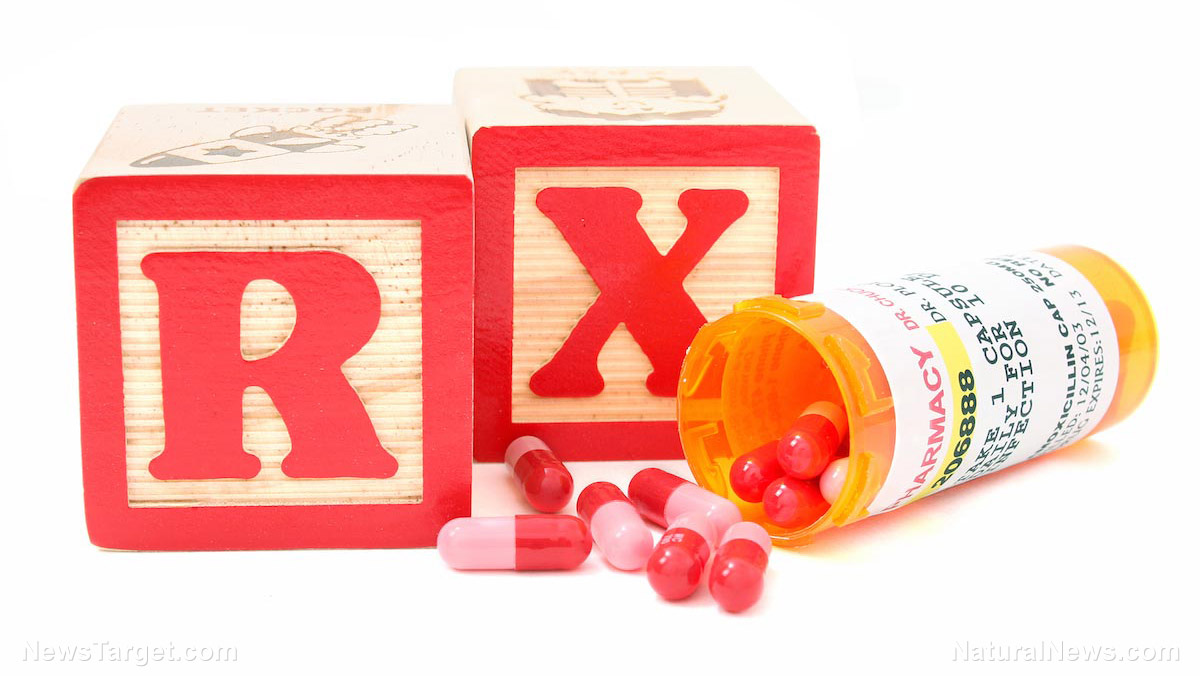Bromelain and Cancer
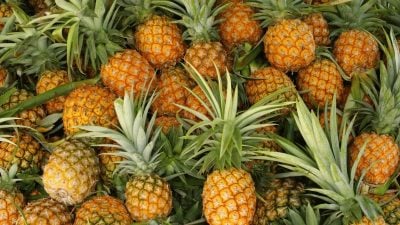
All Global Research articles can be read in 51 languages by activating the Translate Website button below the author’s name (only available in desktop version).
To receive Global Research’s Daily Newsletter (selected articles), click here.
Click the share button above to email/forward this article to your friends and colleagues. Follow us on Instagram and Twitter and subscribe to our Telegram Channel. Feel free to repost and share widely Global Research articles.
Global Research Wants to Hear From You!
***
Papers reviewed:
2023 Jan (Pezzani et al) – Anticancer properties of bromelain: State-of-the-art and recent trends
- Bromelain is an enzyme with a particular proteolytic activity that can be easily obtained from the pineapple stem (Ananas comosus)
Bromelain’s anti-cancer properties have been evaluated extensively in dozens of studies in vitro for: breast cancer, prostate cancer, gastric, colorectal, hepatocellular, cholangiocarcinoma, lung, melanoma, lymphoma and leukemia
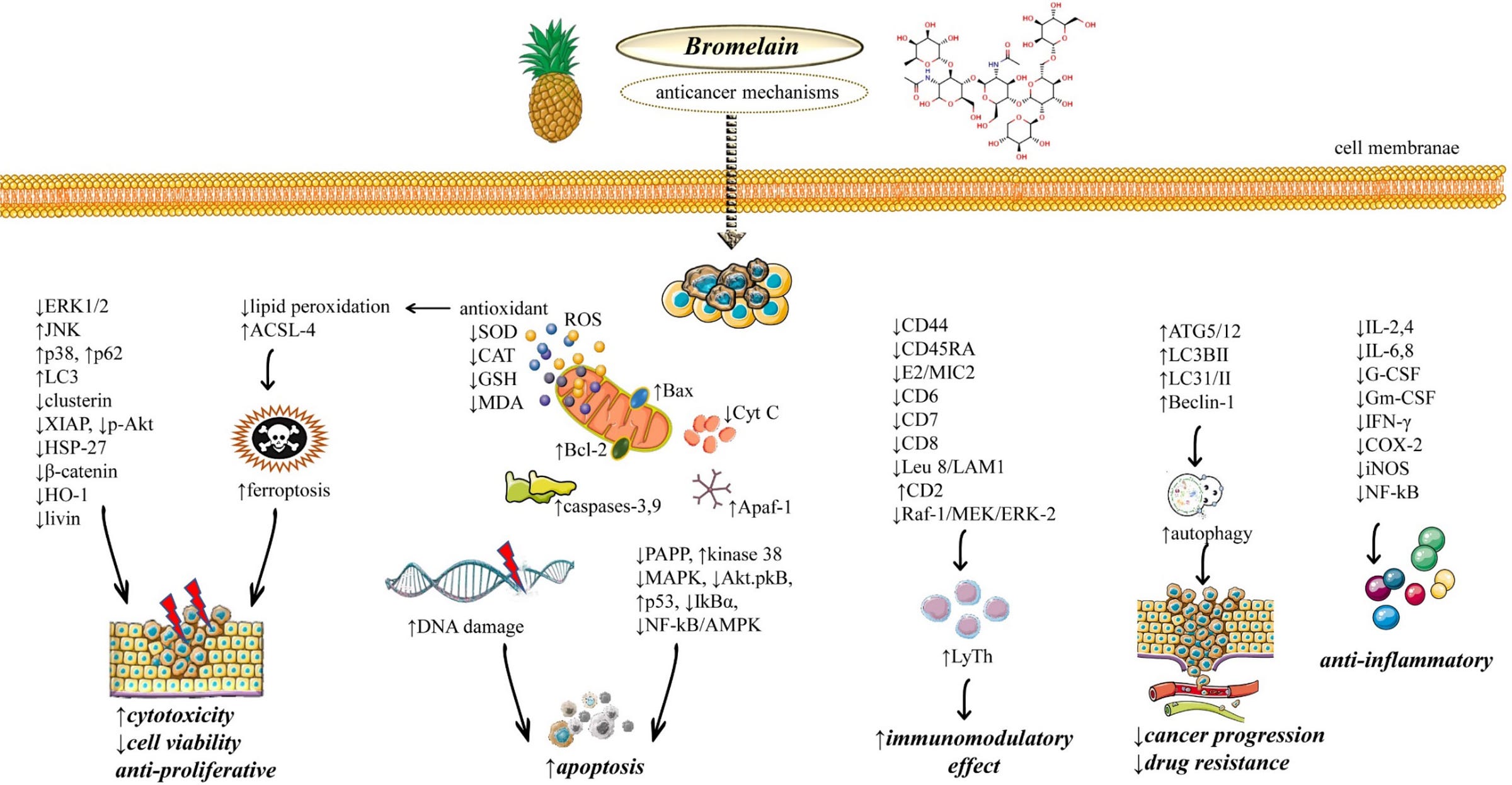
Cytotoxicity: cytotoxic properties of bromelain known since ancient times (traditional Asian Medicine) – due to protease activity. Dose dependent.
- Apoptosis: bromelain can induce both internal and external apoptosis pathways
- autophagy: this mechanism focuses on the degradation and recycling of cellular components. Bromelain increases autophagy of cancer cells.
- Immunomodulatory: bromelain can stimulate or inhibit the immune system
- Stimulates T-cells and other immune cells and their anti-cancer activity
- anti-inflammatory: bromelain has been used since ancient times for its anti-inflammatory properties
- able to reduce inflammation and edema – bromelain reduces vasodilation, and increased capillary permeability, leukocyte migration and local pain by inhibiting the formation of bradykinin and serotonin.
- bromelain also reduces levels of inflammatory cytokines and chemokines
- Reduced cytokines/chemokines expression and alteration of white blood cell trafficking can impact on tumor microenvironment, another possible immune-mediated and anti-cancer effect of bromelain.
- Bromelain can accelerate tissue repair processes as a result of the depolymerization of intercellular structures and modification of vascular permeability (modulation of the arachidonic acid cascade)
- Combined treatment: Bromelain delivery in association with other molecules is often used to obtain a synergistic effect.
- bromelain + peroxidase: increase ROS, upregulate p53
- bromelain + olive leaf: decreased lung carcinogenesis in mice
- bromelain + curcumin + harpagophytum: reduced inflammation
- bromelain + NAC: inhibits growth and proliferation of certain mucinous tumors
- This activity can be traced back to the proteolytic activity of bromelain and the mucolytic activity of NAC
- Some tumors may use mucins during invasion, metastasis and growth in otherwise inhospitable sites
- bromelain + cisplatin: enhanced chemo effect in breast cancer
- more tumor shrinkage than cisplatin alone
- bromelain + radiation therapy: bromelain can act as a radiosensitizer and radio protector of normal tissue
- increased ROS production, inhibition of repair of DNA strand breaks and inhibition of proliferation
Clinical Studies
- bromelain has been studied as an adjuvant treatment in cancer care (not a main treatment but an addition to a main treatment)
- breast cancer patients who took bromelain for 10 days showed increased immunotoxicity effect of monocytes and lymphocytes against breast ca cells
- New drug (BromAc®) combines bromelain + NAC and is used in recurrent thoracic pseudomyxoma peritonei (PMP) treatment (mucolytic properties of BromAc® help the tumor dissolution when it was injected directly into mucinous disease)
- bromelain (in combination with papain, sodium selenite and Lens culinarislectin) has been also tested as a complementary medicine on more than 600 breast cancer patients to reduce the side effects caused by adjuvant hormone therapy.
“Despite these promising effects, the number of clinical trials is low and limited to early stages.”
2021 Nov (Hikisz et al) – Beneficial Properties of Bromelain
- pineapple was valued because of its pleasant, sweet taste, in addition to a wealth of nutrients such as fiber, numerous vitamins, manganese, and copper.
- studies carried out on leaf extracts of pineapple stem have shown that they also contain many biologically attractive alkaloids, flavonoids, saponins, and tannins. Currently, it is believed that the attractive healing properties of this plant can be attributed to the action of bromelain
- bromelain is an enzyme characterized by anti-inflammatory, cardioprotective, immunomodulatory, antioxidant, and anticancer properties.
- Due to its low toxicity, high efficiency, high availability, and relative simplicity of acquisition, it is the object of inexhaustible interest of scientists
- bromelain is a non-toxic compound with therapeutic values, classified as a protein-digesting enzyme protease
- proteases perform many essential functions, e.g., digestion, proliferation control, cell growth and death, regulation of protein synthesis, and degradation.
- bromelain has low systemic toxicity and good absorption in the body while maintaining sufficiently high biological activity.
- safety: Animal experiments have shown that bromelain has very low toxicity with a lethal dose (LD) greater than 10 g/kg body weight.
- Immunomodulatory: Numerous studies indicate that bromelain has very complex immunomodulatory properties realized at many levels of molecular signaling pathways and control of gene expression involved in the immune response.
- bromelain may cause both an increase and a decrease in the activity/expression of the same molecules involved in the immune response
Anti-Cancer Properties
- the exact mechanism of its molecular anticancer activities is still unknown
- It has been suggested that the ability of bromelain to inhibit tumor cell proliferation and metastasis, and induce tumor cell death may be due to its proteolytic and immunomodulatory properties
- Bromelain’s ability to trigger apoptosis is undoubtedly one of its essential features allowing for effective inhibition of cancer development and proliferation
molecular mechanisms of bromelain’s anticancer activity are carried out in many biochemical pathways
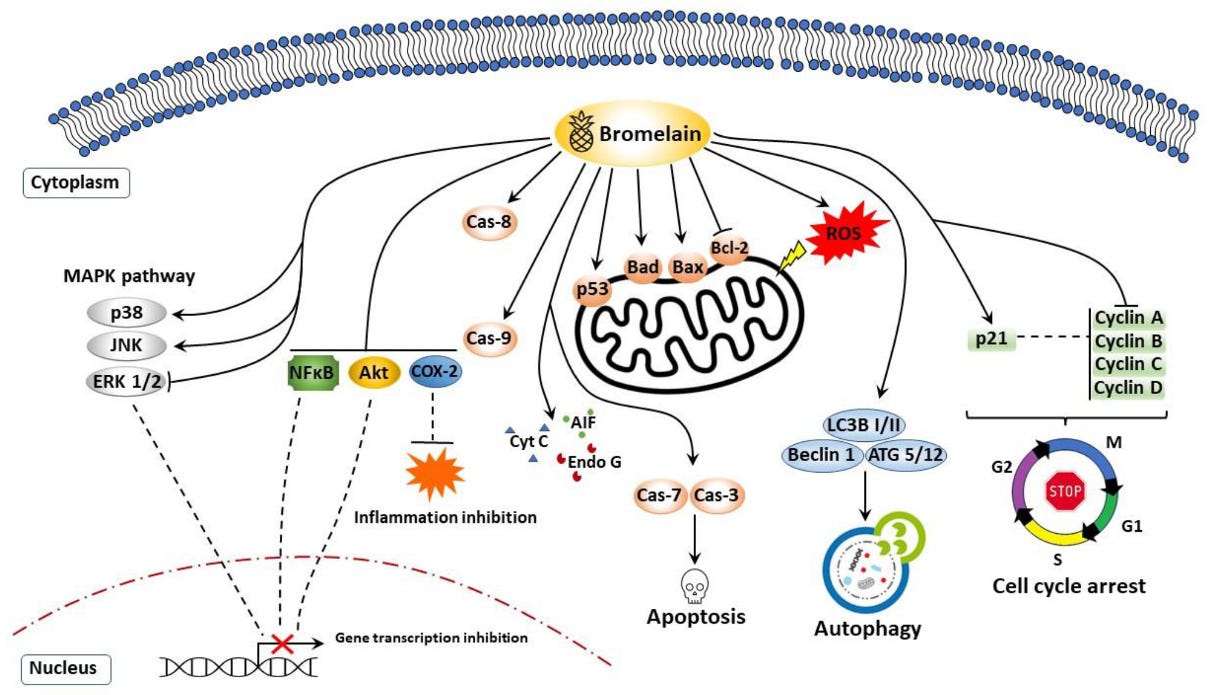
breast cancer – main mechanism is apoptosis, but also enzymatic degradation of cell DNA and inhibition of cancer cell cycle (cell cycle arrest)
- melanoma – bromelain upregulates p53 tumor suppressor protein
- Bromelain-dependent apoptosis induction was associated with modulation of the Bax-Bcl-2 ratio, activation of caspases 3 and 9, and DNA fragmentation
- bromelain’s ability to deplete intracellular glutathione and generation of reactive oxygen species also plays an essential role in fighting melanoma
- leukemias & lymphomas – combining bromelain with pineapple peroxidase is more effective in inhibiting tumor progression than bromelain alone.
- bromelain plus pineapple peroxidase may be a powerful anticancer agent.
- The combination of bromelain-peroxidase caused inhibition of the cell cycle in the G0/G1 phase, and increased intracellular reactive oxygen species (ROS) levels and changes in mitochondrial potential.
- gastrointestinal and colon cancer
- bromelain + NAC combination inhibited the proliferation of human gastric and colon carcinoma cells
- bromelain reduced the development of aberrant crypt foci, polyps, and tumors induced by carcinogens
- worth emphasizing that the MUC1 glycoprotein, which provides tumor cells with invasive, metastatic, and chemo-resistant properties, may be one of the main targets of bromelain’s antitumor activity
- apoptogenic properties of bromelain were realized in the mitochondrial pathway and were associated with the involvement of the caspase system and extranuclear p53, poly (ADP-ribose) polymerase (PARP) degradation.
- Bromelain also appears to impair cancer cell survival by blocking the ERK1/2 and pAkt/Akt, NFκB/MAPK pathway and attenuating Bcl-2 and mucin 1, cell surface associated (MUC1) oncoproteins
- hepatic and pancreatic cancer
- There is a high promise for bromelain, which can proteolytically degrade the extracellular matrix (ECM).
- the role of bromelain is enzymatic degradation of the ECM around the tumor, which results in the enhancement of the penetration of anticancer drugs into the neoplastic tissue of the pancreas. As an anticancer drug delivery system, bromelain plays the role of a specific enhancer of the activity of chemotherapeutic agents
- bromelain + NAC combo given with chemo such as doxorubicin, cisplatin, 5-Fluorouracil (5-FU) may significantly reduce the doses of chemo agents while increasing the effectiveness and minimizing effects of systemic toxicity
“bromelain undoubtedly appears to be a potent inducer of apoptosis and autophagy in tumor cells”
Bromelain is very effective in COVID-19 Vaccine Injury as an enzyme that breaks down the toxic spike protein and many people are already taking it as part of a “spike protein detoxification” protocol.
That it has strong anti-cancer activity is an added bonus.
COVID-19 mRNA Vaccinated individuals who developed Turbo Cancer need a spike protein detoxification, so Bromelain is very helpful with both spike detox and treating the Cancer as well.
In terms of an “Alternative Cancer Treatment”, Bromelain falls into the “Bioactive Compounds – Supplements” category along with others like Quercetin, Olive Leaf, Curcumin, Green Tea Extract, Resveratrol, Berberine, etc.
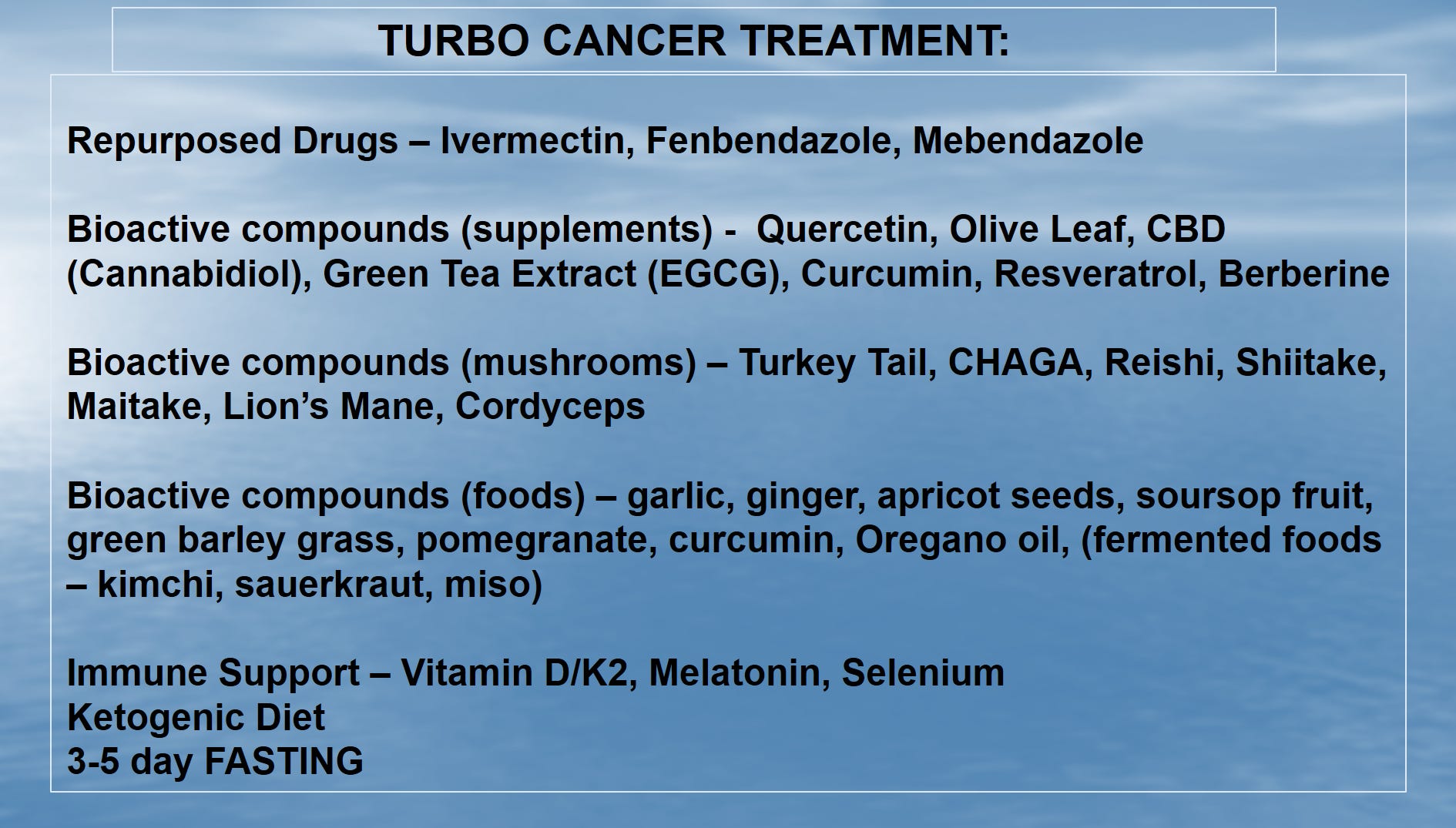
However, Bromelain does have unique properties that other “bioactive compounds” don’t. These include:
- it’s a proteolytic enzyme – has unique cytotoxic effect (dose dependent) as well as an immunomodulatory effect (affects how the immune system deals with cancer) that appears to be extremely complicated
- synergistic effect – works extremely well in combination with other agents
- bromelain + peroxidase: increase ROS, upregulate p53 – effective against leukemias and lymphomas
- bromelain + olive leaf: decreased lung carcinogenesis in mice
- bromelain + curcumin + harpagophytum: reduced inflammation
- bromelain + NAC: inhibits growth and proliferation of certain mucinous tumors (gastric and colorectal)
- powerful stimulator of apoptosis and autophagy
- Due to its low toxicity, high efficiency, high availability, and relative simplicity of acquisition, it is the object of extensive research.
As with most bioactive compounds, the question is how to add Bromelain into a Cancer Treatment Regimen and what doses to supplement with.
The literature does not give much guidance in this regard.
From 2021 paper by Varilla et al:
“Without any significant side effects, it has been recorded that almost 12 g/day of bromelain can be taken in an in vivo study [36]. In addition, bromelain is absorbed in its active form throughout the gastrointestinal tract, with approximately 40 percent of the total bromelain absorbed in its high molecular weight form from the intestine [37]. In terms of pharmacokinetics, the maximal level of bromelain in the blood was obtained an hour after oral dosing [35]. Furthermore, [36] found that bromelain retains its plasma proteolytic function. Based on this, a more recent in vitro test showed that after 4 h, approximately 30% of bromelain remained stable in artificial stomach juiceand that after the same time, roughly 20% of bromelain also remained stable in artificial blood [35].”
Bromelain typically comes in 500mg capsules.
*
Note to readers: Please click the share button above. Follow us on Instagram and Twitter and subscribe to our Telegram Channel. Feel free to repost and share widely Global Research articles.
Dr. William Makis is a Canadian physician with expertise in Radiology, Oncology and Immunology. Governor General’s Medal, University of Toronto Scholar. Author of 100+ peer-reviewed medical publications.
Featured image is from COVID Intel


